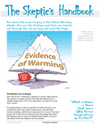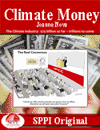|
|
The line blurs between peer-reviewed-science and peer-reviewed-public-relations.
The Big-Scare-Campaign needed an answer to the missing hot-spot question. They needed to find the “hot spot”, or failing that, at the very least provide a “hot spot” type graph that would answer the critics; something that passed for a scientific answer that might fool journalists and bloggers. The failure to find the projected hot spot is so damning, and so obviously not what the models predicted, that there is a veritable industry of people working hard to find a reason why the weather balloon results must be wrong. Steven Sherwood creatively even resorted to throwing out the thermometer readings entirely and using wind shear instead. (If only we’d known! All those years and we didn’t need the thermometers?)
In Robust Tropospheric Warming Revealed by Iteratively Homogenized Radiosonde Data (March 2008) Sherwood et al combine both windshear and temperature data to reconsider the radiosondes yet again. The Scientific Guide to The Skeptics Handbook and others use the graph from the top left corner of this paper (Fig 1 here) to suggest that the hot spot is not missing, or that the “fingerprint” was found. Sure enough, it’s a cute graph. Looks “hot”, right?
[…]
John Cook might be skeptical about skeptics, but when it comes to government funded committee reports, not so much.
The author of “skeptical science” has finally decided to try to point out things he thinks are flaws in The Skeptics Handbook. Instead, he misquotes me, shies away from actually displaying the damning graphs I use, gets a bit confused about the difference between a law and a measurement, unwittingly disagrees with his own heroes, and misunderstands the climate models he bases his faith on. Not so “skeptical” eh John? He’s put together a page of half-truths and sloppy errors and only took 21 months to do it. Watch how I use direct quotes from him, the same references, and the same graphs, and trump each point he tries to make. His unskeptical faith in a theory means he accepts some bizarre caveats while trying to whitewash the empirical findings.
In the end, John Cook trusts the scientists who collect grants funded by the fear-of-a-crisis and who want more of his money, but he’s skeptical of unfunded scientists who ask him to look at the evidence and tell him to keep his own cash.
These two graphs are not the same […]
The debate with Paleoclimatologist Dr Andrew Glikson about the evidence for Climate change has reached a telling point. There is a gaping hole.
Through four rounds of to and fro, I’ve been asking for evidence that the predicted (critical) “hot spot” was there above the equator, and we were drilling down to this point. It’s the weak link in the chain of evidence, and if the climate models are wrong on this element, you can kiss goodbye to the catastrophe. Everything else might be right, but there’s no major warming if there’s no strong amplifying (positive) feedback, and and there is no amplifying feedback from water vapor if there is no hot spot. Indeed, I quoted evidence from three peer reviewed studies that show that we’re headed for a half a measly degree of warming rather than a baking 3 – 6 degrees.
In Round 2 Glikson didn’t mention Lindzen, Spencer or Douglass (the three independent papers which suggest that predicted feedbacks are missing or negative). Instead he suggested “Sherwood 2008” found the hot-spot. I pointed out that Sherwood used wind-gauges instead of thermometers. To believe he is right we need to throw out thousands of thermometer readings and […]
UPDATED Part IV: Andrew Glikson replies below.
I am impressed that Glikson replied politely, rose above any ad hominem or authority based arguments, and focused on the science and the evidence. This kind of exchange is exceedingly rare, and it made it well worth continuing. Links to Part I and II are at the end. Round 4 was copied from comments up to the post.
Depending on flawed models
by Joanne Nova
May 11, 2010
For a sentence, I almost think Dr Glikson gets it. Yes, it’s a quantitative question: Will we warm by half a measly degree or 3.5 degrees? It’s not about the direct CO2 effect (all of one paltry degree by itself), it’s the feedbacks—the humidity, clouds, lapse rates and other factors that amplify (or not) the initial minor effect of carbon.
Decades ago, the catastrophe-crowd made guesses about the feedbacks—but they were wrong. Instead of amplifying carbon’s effect two-fold (or more!) the feedbacks dampen it.
Dr Glikson has no reply. He makes no comment at all about Lindzen [1], Spencer[2] or Douglass[3] and their three peer reviewed, independent, empirical papers showing that the climate models are exaggerating the warming by […]
Dr Andrew Glikson (an Earth and paleoclimate scientist, at the Australian National University) contacted Quadrant offering to write about the evidence for man-made global warming. Quadrant approached me asking for my response. Dr Glikson replied to my reply, and I replied again to him (copied below). No money exchanged hands, but Dr Glikson is, I presume, writing in an employed capacity, while I write pro bono. Why is it that the unpaid self taught commentator needs to point out the evidence he doesn’t seem to be aware of? Why does a PhD need to be reminded of basic scientific principles (like, don’t argue from authority). Such is the vacuum of funding for other theories that a debate that ought to happen inside the university obviously hasn’t occurred. Such is the decrepit, anaemic state of university science that even a doctorate doesn’t guarantee a scientist can reason. Where is the rigor in the training, and the discipline in the analysis?
Credibility lies on evidence
by Joanne Nova
April 29, 2010
Reply to Andrew Glikson
Dr Andrew Glikson still misses the point, and backs his arguments with weak evidence and logical errors. Instead of empirical evidence, often […]
Dr Andrew Glikson writes for Quadrant and I respond .
This is a copy. It begs the question. Dr Glikson, is an Earth and paleo-climate scientist at the Australian National University. He’s paid to give us both sides of the story.
No, Dr Glikson
by Joanne Nova
April 19, 2010
Dr Andrew Glikson says the right motherhood lines [see: Case for Climate Change]: he talks about empirical evidence, and wants evidence based policies. All this is good, yet he sidesteps the main point — what exactly is the evidence for the theory of man-made global warming? It’s the only point that matters, yet when he presents evidence it’s either not empirical, not up to date, or not relevant. Why?
By hitting all the right key phrases a reader might accidentally think that Glikson is presenting key evidence and good reasoning. Take this for example: Glikson fears we’re turning away from evidence-based policies. (Me too!) But to complete the sentence he lists all the committees who predict bad weather 90 years from now. It makes for good PR, but is not scientific evidence.
Committee reports count as “evidence” in a court of law, but in science, certificates, declarations, contracts, commission […]
Carbon dioxide only causes 1.1°C of warming if it doubles. That’s according to the IPCC. Did you know?
The real game is water.
Researchers made guesses about humidity and clouds in the early 1980s and they built these guesses into their models. We now know they were wrong, not about carbon, but about water in the form of humidity and clouds. Here’s how the models can be right about carbon and wrong about the climate.
7.5 out of 10 based on 11 ratings […]
Big names like Santer, Sherwood, and Schmidt admit that the models predict more warming 10 km above the equator than what the weather balloons could find. Each time they announce that they’ve resolved the differences, they have to start by admitting there are differences to resolve. […]
This is vintage spinmeister-Tim. Overall he claims I’m deluded, confused, constantly repeating discredited arguments, “doesn’t even know what the hot-spot is”, and “doesn’t understand how the greenhouses gases warm the planet”. But when it comes to backing up the giant patronizing put-downs, it amounts to nit-picking phraseology; irrelevant points; straw men; his own false understanding of what a fingerprint is; and then an own goal when he drops in a graph that shows that the hot-spot is indeed missing. […]
The gap between real world data and thermometers is a make-or-break issue for the AGW theory. The models predict a hot-spot in the atmosphere above the tropics, but the weather balloons (called radiosondes) can’t find any sign of it. Most claims that the hot-spot has been found are not providing any new data, they are just massaging the same old numbers with a different statistical tool. Here are three variations (though the third is not a statistical-spin, it’s just nonsense).
1–Some AGW supporters claim that Santer et al has found the hot-spot. But his paper boils downs to a statistical reanalysis that suggests that due to noise and error, the hot-spot might be there. Santer hasn’t actually found the missing hot spot. He has a case, but it’s not a strong one. The statistical counterargument is at Climate Audit.
5.5 out of 10 based on 10 ratings […]
The ‘Hotspot’ is crucial to the climate debate.
If greenhouses gases are warming the planet that warming will happen first in the cold blob of air 8-12 km above the tropics. It’s freezing cold up there, but it ought to be slightly less freezing cold thanks to greenhouse gases. All 20-odd climate models predict warming there first—it’s the fingerprint of greenhouse gas warming, as opposed to warming by some other cause, like solar magnetic effects, volcanic eruptions, solar irradiance, or ozone depletion etc etc.
Look at A above, the greenhouse gas fingerprint is markedly different from the rest and dominates the overall predicted pattern in graph F. The big problem for the believers of AGW is that years of radiosonde measurements can’t find any warming, as shown in part E of Figure 5.7 in section 5.5 on page 116 of the US CCSP 2006 report
8.7 out of 10 based on 38 ratings […]
|
JoNova A science presenter, writer, speaker & former TV host; author of The Skeptic's Handbook (over 200,000 copies distributed & available in 15 languages).

Jo appreciates your support to help her keep doing what she does. This blog is funded by donations. Thanks!


 Follow Jo's Tweets
Follow Jo's Tweets To report "lost" comments or defamatory and offensive remarks, email the moderators at: support.jonova AT proton.me
Statistics
The nerds have the numbers on precious metals investments on the ASX
|












Recent Comments